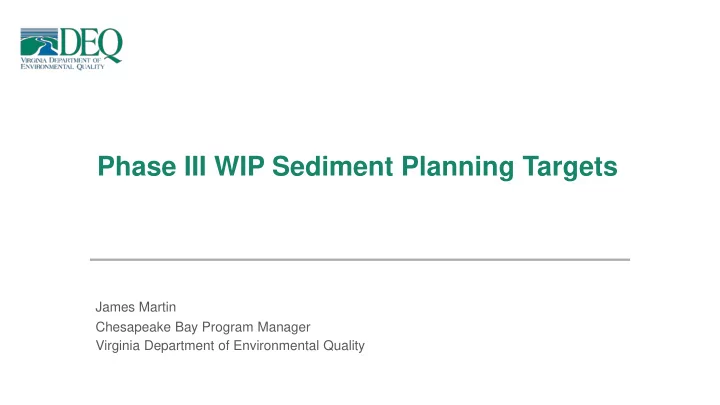

Phase III WIP Sediment Planning Targets James Martin Chesapeake Bay Program Manager Virginia Department of Environmental Quality
State-Basin Nutrient Planning Targets Nitrogen Phosphorus State-Basin (million pounds per year) (million pounds per year) Eastern Shore 1.43 0.164 Potomac River Basin 16 1.892 Rappahannock River Basin 6.85 0.849 York River Basin 5.52 0.556 James River Basin 25.92 2.731 Total for Virginia 55.73 6.192 2
Sediment Targets • Sediment loads are managed to address the water clarity/submerged aquatic vegetation (SAV) WQS • Excessive sediment in the water column can reduce light to levels insufficient for SAV growth • Most of the nutrient reducing BMPs also remove considerable loads of sediment. • BMPs implemented to achieve nutrient load targets for Deep Water and Deep Channel dissolved oxygen (DO), are sufficient to meet the sediment-based water clarity/SAV WQS. • Recent research in the Bay suggests that water clarity/SAV WQS is generally more responsive to nutrient load reductions than it is to reduction of sediment loads. 3
Sediment Targets • Narrative in WIP III describing the development of sediment targets (Chapter 5.2, pg 29) • Same process as used in Phase 1 and Phase 2 WIPs • Based on WIP III BMPs identified to meet the Bay nutrient targets • Resulting sediment loads form the basis for the sediment targets • Adjusted proportionally to account for any overshooting or undershooting • 10% allowance added to the calculated sediment target in each major basin. 4
Sediment Targets • Final WIPs Released 8/23/2019 • Sediment Targets developed by Bay Program • Approval by Bay Partnership • Appended to the WIP III in October, 2019 • The Sediment Targets will not affect the BMPs called for in the WIP III • Sediment Targets are not intended to be the driver for implementation moving forward 5
Phase III WIP Sediment Planning Targets Questions? James Martin Chesapeake Bay Program Manager Virginia Department of Environmental Quality 7/18/2019
Recommend
More recommend